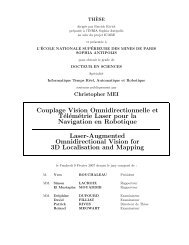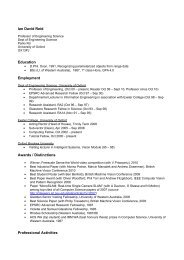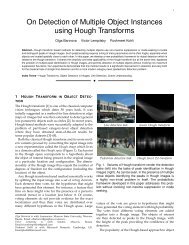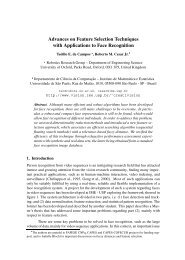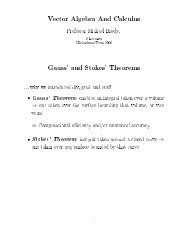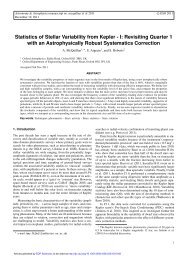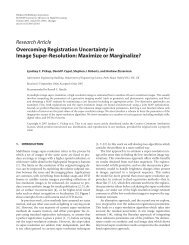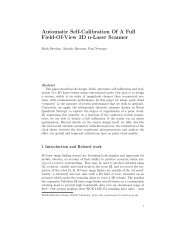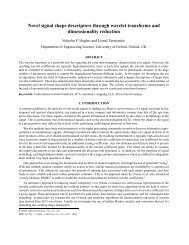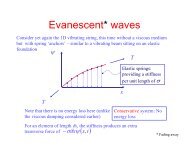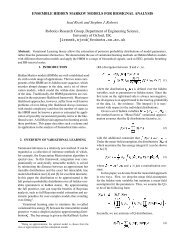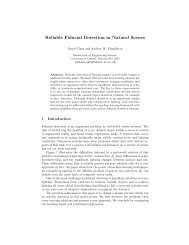Physiological Basis of the Electrocardiogram
Physiological Basis of the Electrocardiogram
Physiological Basis of the Electrocardiogram
Create successful ePaper yourself
Turn your PDF publications into a flip-book with our unique Google optimized e-Paper software.
1.3 Introduction to Clinical Electrocardiography: Abnormal Patterns 13<br />
<strong>the</strong> medulla in <strong>the</strong> brain stem and <strong>the</strong> hypothalamus. Instructions from <strong>the</strong>se centers<br />
are communicated via nerves that connect <strong>the</strong> brain to <strong>the</strong> heart. There are two<br />
main sets <strong>of</strong> nerves serving <strong>the</strong> sympa<strong>the</strong>tic and <strong>the</strong> parasympa<strong>the</strong>tic portions <strong>of</strong> <strong>the</strong><br />
autonomic nervous system, which both innvervate <strong>the</strong> heart. The sympa<strong>the</strong>tic nervous<br />
system is activated during stressful times. It increases <strong>the</strong> rate <strong>of</strong> SA node firing<br />
(hence raising heart rate) and also innervates <strong>the</strong> myocardium itself, increasing <strong>the</strong><br />
propagation speed <strong>of</strong> <strong>the</strong> depolarization wavefront, mainly through <strong>the</strong> AV node,<br />
and increasing <strong>the</strong> strength <strong>of</strong> mechanical contractions. These effects are all consequences<br />
<strong>of</strong> changes to ion channels and gates that occur when <strong>the</strong> cells are exposed<br />
to <strong>the</strong> messenger chemical from <strong>the</strong> nerves. The time necessary for <strong>the</strong> sympa<strong>the</strong>tic<br />
nervous system to actuate <strong>the</strong>se effects is on <strong>the</strong> order <strong>of</strong> 15 seconds.<br />
The sympa<strong>the</strong>tic system works in tandem with <strong>the</strong> parasympa<strong>the</strong>tic system. For<br />
<strong>the</strong> body as a whole, <strong>the</strong> parasympa<strong>the</strong>tic system controls quiet-time functions like<br />
food digestion. The nerve through which <strong>the</strong> parasympa<strong>the</strong>tic system communicates<br />
with <strong>the</strong> heart is named <strong>the</strong> vagus. 15 The parasympa<strong>the</strong>tic branch’s major effect is<br />
on heart rate and <strong>the</strong> velocity <strong>of</strong> propagation <strong>of</strong> <strong>the</strong> action potential through <strong>the</strong> AV<br />
node. 16 Fur<strong>the</strong>rmore, in contrast with <strong>the</strong> sympa<strong>the</strong>tic system, <strong>the</strong> parasympa<strong>the</strong>tic<br />
nerves act quickly, decreasing <strong>the</strong> velocity through <strong>the</strong> AV node and slowing <strong>the</strong><br />
heart rate within a second when <strong>the</strong>y activate. Most organs are innervated by both<br />
<strong>the</strong> sympa<strong>the</strong>tic and <strong>the</strong> parasympa<strong>the</strong>tic branches <strong>of</strong> <strong>the</strong> ANS and <strong>the</strong> balance<br />
between <strong>the</strong>se competing effects determines function.<br />
The sympa<strong>the</strong>tic and parasympa<strong>the</strong>tic systems are rarely totally <strong>of</strong>f or on; instead,<br />
<strong>the</strong> body adjusts <strong>the</strong>ir levels <strong>of</strong> activation, known as tone, as is appropriate<br />
to its needs. If a medication that inactivates <strong>the</strong> sympa<strong>the</strong>tic system (e.g., propranolol)<br />
is used on a healthy resting subject with a heart rate <strong>of</strong> 60 bpm, <strong>the</strong> classic<br />
response is to slow <strong>the</strong> heart rate to about 50 bpm. If a medication that inactivates<br />
<strong>the</strong> parasympa<strong>the</strong>tic system (e.g., atropine) is used, <strong>the</strong> classic response is an elevation<br />
<strong>of</strong> <strong>the</strong> heart rate to about 120 bpm. If you administer both medications and<br />
inactivate both systems (parasympa<strong>the</strong>tic and sympa<strong>the</strong>tic withdrawal), <strong>the</strong> heart<br />
rate rises to 100 bpm. Therefore, in this instance for normal subjects at rest, <strong>the</strong><br />
effects <strong>of</strong> <strong>the</strong> heart rate’s “brake” are greater than <strong>the</strong> effects <strong>of</strong> <strong>the</strong> “accelerator,”<br />
although it is <strong>the</strong> balance <strong>of</strong> both systems that dictates <strong>the</strong> heart rate. The body’s<br />
normal reaction when vagal tone is increased (<strong>the</strong> brake) is to simultaneously reduce<br />
sympa<strong>the</strong>tic tone (<strong>the</strong> accelerator). Similarly, when sympa<strong>the</strong>tic tone is increased,<br />
parasympa<strong>the</strong>tic tone is usually withdrawn. Indeed, if a person is suddenly startled,<br />
<strong>the</strong> earliest increase in heart rate will simply be due to parasympa<strong>the</strong>tic withdrawal<br />
ra<strong>the</strong>r than <strong>the</strong> slower-acting sympa<strong>the</strong>tic activation.<br />
On what basis does <strong>the</strong> autonomic system make heart rate adjustments? There<br />
are a series <strong>of</strong> sensors throughout <strong>the</strong> body sending information back to <strong>the</strong> brain<br />
(afferent nerves, bringing information to <strong>the</strong> central nervous system). Those<br />
parameters sensed by afferent nerves include <strong>the</strong> blood pressure in <strong>the</strong> arteries<br />
(baroreceptors), <strong>the</strong> acid-base conditions in <strong>the</strong> blood (chemoreceptors), and <strong>the</strong><br />
pressure within <strong>the</strong> heart’s walls (mechanoreceptors). Based on this feedback, <strong>the</strong><br />
brain unconsciously adjusts heart rate. The system is predicated on <strong>the</strong> fact that,<br />
15. Parasympa<strong>the</strong>tic activity is <strong>the</strong>refore sometimes termed vagal activity.<br />
16. It has little effect on cardiac contractility.



